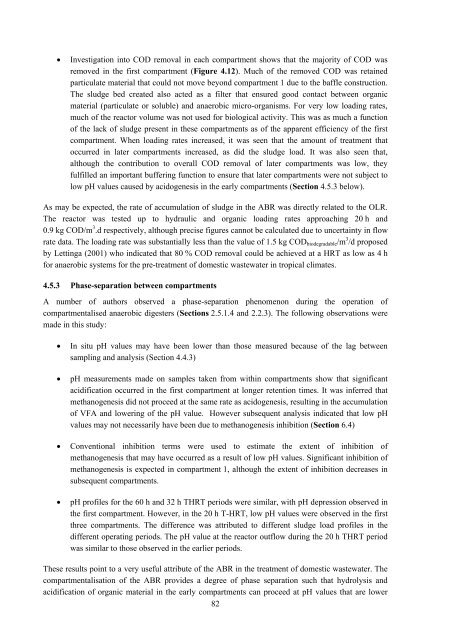analysis of a pilot-scale anaerobic baffled reactor treating domestic ...
analysis of a pilot-scale anaerobic baffled reactor treating domestic ...
analysis of a pilot-scale anaerobic baffled reactor treating domestic ...
Create successful ePaper yourself
Turn your PDF publications into a flip-book with our unique Google optimized e-Paper software.
• Investigation into COD removal in each compartment shows that the majority <strong>of</strong> COD was<br />
removed in the first compartment (Figure 4.12). Much <strong>of</strong> the removed COD was retained<br />
particulate material that could not move beyond compartment 1 due to the baffle construction.<br />
The sludge bed created also acted as a filter that ensured good contact between organic<br />
material (particulate or soluble) and <strong>anaerobic</strong> micro-organisms. For very low loading rates,<br />
much <strong>of</strong> the <strong>reactor</strong> volume was not used for biological activity. This was as much a function<br />
<strong>of</strong> the lack <strong>of</strong> sludge present in these compartments as <strong>of</strong> the apparent efficiency <strong>of</strong> the first<br />
compartment. When loading rates increased, it was seen that the amount <strong>of</strong> treatment that<br />
occurred in later compartments increased, as did the sludge load. It was also seen that,<br />
although the contribution to overall COD removal <strong>of</strong> later compartments was low, they<br />
fulfilled an important buffering function to ensure that later compartments were not subject to<br />
low pH values caused by acidogenesis in the early compartments (Section 4.5.3 below).<br />
As may be expected, the rate <strong>of</strong> accumulation <strong>of</strong> sludge in the ABR was directly related to the OLR.<br />
The <strong>reactor</strong> was tested up to hydraulic and organic loading rates approaching 20 h and<br />
0.9 kg COD/m 3 .d respectively, although precise figures cannot be calculated due to uncertainty in flow<br />
rate data. The loading rate was substantially less than the value <strong>of</strong> 1.5 kg CODbiodegradable/m 3 /d proposed<br />
by Lettinga (2001) who indicated that 80 % COD removal could be achieved at a HRT as low as 4 h<br />
for <strong>anaerobic</strong> systems for the pre-treatment <strong>of</strong> <strong>domestic</strong> wastewater in tropical climates.<br />
4.5.3 Phase-separation between compartments<br />
A number <strong>of</strong> authors observed a phase-separation phenomenon during the operation <strong>of</strong><br />
compartmentalised <strong>anaerobic</strong> digesters (Sections 2.5.1.4 and 2.2.3). The following observations were<br />
made in this study:<br />
• In situ pH values may have been lower than those measured because <strong>of</strong> the lag between<br />
sampling and <strong>analysis</strong> (Section 4.4.3)<br />
• pH measurements made on samples taken from within compartments show that significant<br />
acidification occurred in the first compartment at longer retention times. It was inferred that<br />
methanogenesis did not proceed at the same rate as acidogenesis, resulting in the accumulation<br />
<strong>of</strong> VFA and lowering <strong>of</strong> the pH value. However subsequent <strong>analysis</strong> indicated that low pH<br />
values may not necessarily have been due to methanogenesis inhibition (Section 6.4)<br />
• Conventional inhibition terms were used to estimate the extent <strong>of</strong> inhibition <strong>of</strong><br />
methanogenesis that may have occurred as a result <strong>of</strong> low pH values. Significant inhibition <strong>of</strong><br />
methanogenesis is expected in compartment 1, although the extent <strong>of</strong> inhibition decreases in<br />
subsequent compartments.<br />
• pH pr<strong>of</strong>iles for the 60 h and 32 h THRT periods were similar, with pH depression observed in<br />
the first compartment. However, in the 20 h T-HRT, low pH values were observed in the first<br />
three compartments. The difference was attributed to different sludge load pr<strong>of</strong>iles in the<br />
different operating periods. The pH value at the <strong>reactor</strong> outflow during the 20 h THRT period<br />
was similar to those observed in the earlier periods.<br />
These results point to a very useful attribute <strong>of</strong> the ABR in the treatment <strong>of</strong> <strong>domestic</strong> wastewater. The<br />
compartmentalisation <strong>of</strong> the ABR provides a degree <strong>of</strong> phase separation such that hydrolysis and<br />
acidification <strong>of</strong> organic material in the early compartments can proceed at pH values that are lower<br />
82
















